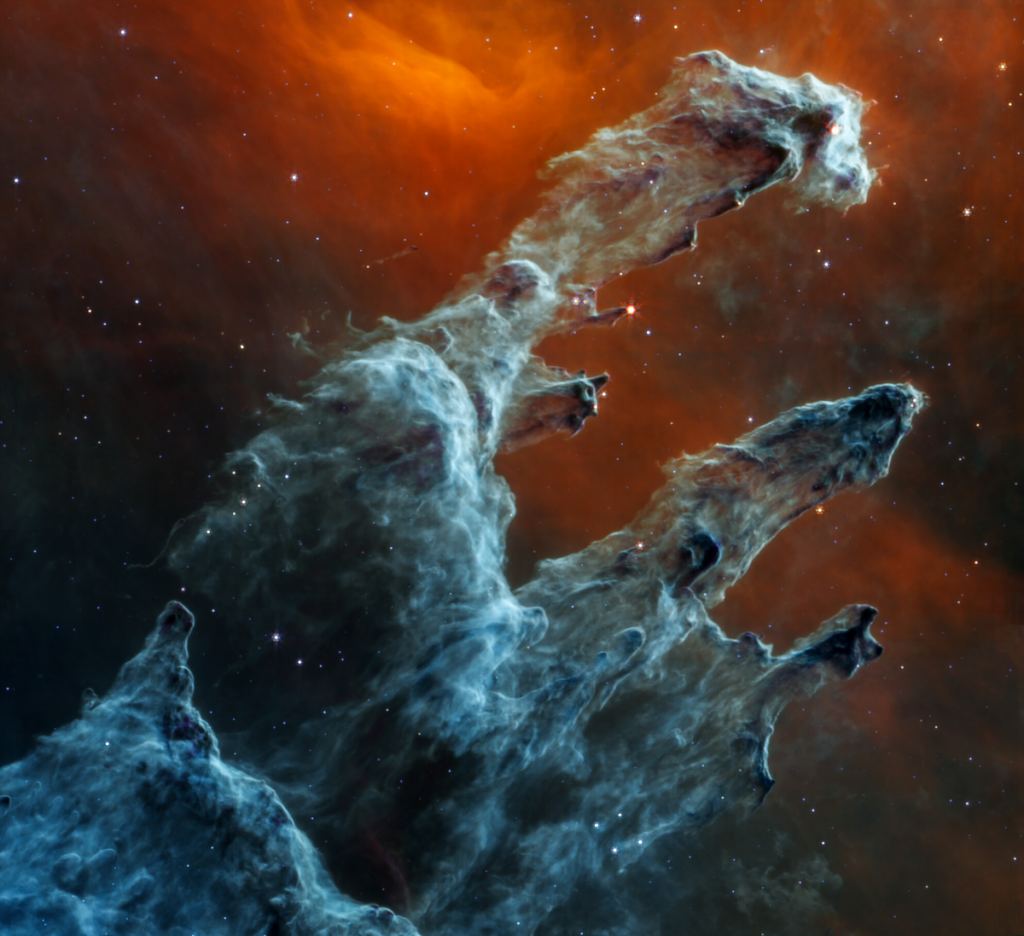The hits just keep on streaming back to Earth from James Webb Space Telescope (JWST). This time, arriving to help celebrate Hallowe’en, data from the MIRI mid-infrared instrument onboard JWST shows another view of the Pillars of Creation. Thousands of stars are embedded in those pillars, but many are “invisible” to MIRI.
In the latest image, the Pillars have a steely gray look about them. They almost look like cosmic gravestones instead of stellar birthplaces. Why is this? Mid-infrared light is an important part of the spectrum for astronomers interested in studying clouds of dust.
It reveals gas and dust in extreme detail. The densest areas of dust in the pillars show up as the darkest shades of grey. The red V-shaped region toward the top is where the dust clouds are thinner and cooler.
At these wavelengths, MIRI is only able to “see” the young stars still embedded in their gas and dust cocoons. They glow a mysterious red—almost like the eyes of jack-o-lanterns—at the tips of formations in the pillars. The blue-looking stars are older ones that have burst free and eaten their birth clouds away.
The Pillars of Creation in Retrospect This star-birth region has a long history of observations. It’s certainly visible to astronomers using backyard-type telescopes. However, it takes Hubble Space Telescope and now JWST to dig into the rich detail of this massive cloud.
HST first looked at it in 1995, using the Wide Field and Planetary Camera 2. It returned 32 images, which were combined into a mosaic. The pillars are part of the Eagle Nebula.
It’s a diffuse emission nebula that covers a region of space about 70 x 55 light-years across. It lies about 6,500 light-years away from us. The pillars are a part of the nebula, and some of its tiniest stellar birthplaces are larger than our solar system.
Eagle Nebula Pillars of Creation as seen by Hubble Space Telescope in 2005. (Credit NASA, ESA, STScI, J. Hester and P.
Scowen (ASU) When the first HST image appeared, astronomers could see the places where stars were born and are eating away at their gas clouds but couldn’t see INTO the clouds. Those hungry stellar babies in their cocoons were dubbed “evaporating gaseous globules”, or EGGs. They’re in other stellar nurseries, giving astronomers a good idea of how star birth progresses in thick clouds of gas and dust.
The Pillars of Creation have since been imaged by the Chandra X-ray Observatory (which found no x-ray sources associated with the newborn stars). Spitzer Space Telescope also studied this region of space. It found evidence of hot gases that suggested a supernova exploded in the area.
If it did, there’s little evidence of the shock wave hurting the stellar newborns or evaporating the rest of the cloud away. JWST’s Looks at the Pillars The latest steely gray view of the Pillars of Creation set against the glowing red and gray backdrop isn’t JWST’s first rodeo with this region of space. Earlier in October, the science teams released a NIRCam (Near Infrared Camera) image of it.
That view revealed many of the protostars forming inside those cosmic stalagtites in space. Thanks to NIRCam, we can peer right through the gas and dust, lifting the veil on star birth. A compare and contrast of a 2014 HST view of the Pillars of Creation and the October 19, 2022, JWST image.
Both views show us what is happening locally. Although Hubble highlights many more thick layers of dust and Webb shows more of the stars, neither shows us the deeper universe. Dust blocks the view in Hubble’s image, but the interstellar medium plays a major role in Webb’s.
It acts like thick smoke or fog, preventing us from peering into the deeper universe, where countless galaxies exist. Courtesy of NASA, ESA, CSA, STScI, Hubble Heritage Project (STScI, AURA) Image processing: Joseph DePasquale (STScI), Anton M. Koekemoer (STScI), Alyssa Pagan (STScI) The protostars as seen by NIRCam are the ones with multiple diffraction spikes.
They’re still accreting mass, and when they get enough, they’ll collapse under their own gravity and slowly heat up. When they’re hot and massive enough, fusion will ignite in their cores. That’s when they become stars.
The young stars in these pillars are probably only a few hundred thousand years old and won’t be finished forming for millions of years. The stellar birth process often creates jets that shoot out from the newborn stars. Those jets eat away at the remaining birth cloud materials.
They sculpt the clouds, which is why the pillars look wavy and deformed. Understanding Star Formation from JWST Images Both of these JWST images of the Pillars of Creation give astronomers a more detailed look at star formation. While scientists have a pretty good overall view of how stars form, the intricate details are what they need.
All that data about star birth will help create better models of such an important process. Compare and contrast the NIRCam view (left) with the MIRI view (right) from JWST to understand how each instrument sees the Pillars of creation. NASA, ESA, CSA, STScI; J.
DePasquale (STScI), A. Pagan (STScI), A. Koekemoer (STScI) By looking at populations of newborns like the ones in the Pillars, and mapping the huge clouds of gas and dust in this region, they’ll add to the store of knowledge about star birth.
Images such as these also give a good look at what our own region of space must have looked like about five billion years ago. That’s when our own Sun and its stellar siblings began to form from a similar type of gas and dust cloud. .
For More Information Haunting portrait: Webb reveals dust and structure in Pillars of CreationPillars of Creation: Hubble and Web Images Side by SideEagle Nebula “Pillars of Creation“ The post Another Version of the Pillars of Creation from Webb appeared first on Universe Today. .
From: universetoday
URL: https://www.universetoday.com/158384/another-version-of-the-pillars-of-creation-from-webb/
